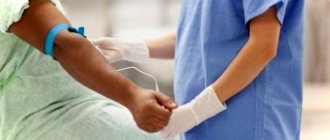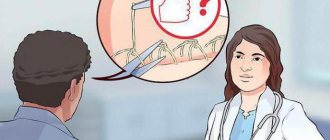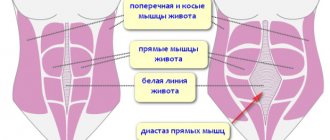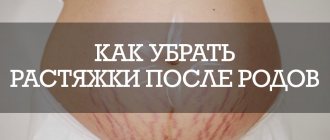Childbirth is an amazing process of bringing a new person into the world, and for the female body it is a test of strength. It is not always the case that stretched or even torn tissues regain their original elasticity. In this case, surgeons come to the rescue. Intimate plastic surgery gives a chance to restore a full sexual life even after serious breakups.
- Why is there a need for intimate plastic surgery after childbirth?
- In what cases is it necessary?
- Types of Vaginoplasty
- Perineal plastic surgery
- Labiaplasty
About the operation
Abdominoplasty is a surgical correction of the shape of the abdomen with skin tightening and suturing of stretched muscle and tendon fibers.
Most often, mothers think about surgery after pregnancy and childbirth. To give birth to a new life, a woman sacrifices her figure. The skin that suffers the most is the skin of the abdomen, which is subject to severe stretching over the course of 9 months as the baby grows. Together with the skin, the muscle fibers lengthen, and the linea alba is deformed.
As a result, many women after childbirth develop a saggy belly, stretch marks, and unattractive sides. Only a few with good elasticity of the skin and muscles manage to avoid anatomical metamorphosis; for the rest, plastic surgery becomes the only salvation.
Is it possible to remove stretch marks on the stomach?
Olga Fem: Is it possible to remove stretch marks in the abdominal area?
Denishchuk P.A.: With the help of abdominoplasty, you can remove stretch marks that appear after pregnancy and are very bothersome to women. Abdominoplasty removes stretch marks from the navel to the pubic area - this is where stretch marks usually occur the most.
But stretch marks that are located above the navel cannot be removed, because they will move to the pubis. That is, the meaning of abdominoplasty: the skin apron is removed from the navel to the pubis.
Olga Fem: So during the operation the area of skin where there are stretch marks is simply cut out?
Denishchuk P.A.: Yes, but the stretch marks that were above the navel will move lower and remain.
Olga Fem: To summarize:
- First of all, you need to control your weight and not gain more than 12-15 kg during pregnancy.
- During pregnancy, wear a bandage and rub nourishing creams into the skin of the abdomen to improve its elasticity and prevent the appearance of stretch marks.
- After childbirth, as soon as the doctor allows you to start physical activity, perform physical exercises that will help bring your muscles to normal tone.
- Use tonic creams that will help the skin contract.
- If possible, use manual, hardware massage and other non-invasive correction methods.
Denishchuk P.A.: I would advise you to consult first, because each patient has her own characteristics. A short consultation, literally half an hour, and specialists will write out a program on how to care for such skin. If a woman has a small child and cannot go anywhere, this can be done at home.
Indications for abdominoplasty after childbirth
A slight weight gain while carrying a child is not yet a reason to resort to plastic surgery. Often a small tummy can be removed with exercise and proper nutrition. But there are changes after childbirth for which tummy tuck is indispensable:
- strongly stretched, loose skin on the abdomen, which, after losing weight, sagged in the form of a skin-fat “apron”;
- small fat deposits in the lower abdomen;
- deformed aponeurosis – development of abdominal diastasis;
- formation of an umbilical hernia;
- change in the localization of the navel - its displacement down or to the sides.
After a difficult birth by caesarean section, abdominoplasty is indicated when a rough, pronounced scar is formed, as well as if the fat layer around the scar is unevenly distributed and causes abdominal deformation.
Navel surgery after childbirth
The postpartum condition of the navel does not always please a young woman, so she has to seek help from a plastic surgeon, since it is almost impossible to cope with this problem on her own.
Umbilical hernia is one of the very common and serious postpartum problems . In simple words, this is a protrusion of the internal organs of the abdominal cavity due to a weakening of the muscle corset in the navel area - diastasis. In this case, the navel in the form of a ball protrudes above the surface of the abdomen.
An umbilical hernia occurs due to weakening of the abdominal muscles
The essence of the operation is a circular or oval incision around the navel. The doctor then moves the rectus abdominis muscles back into place, removes excess fat and tissue, and reshapes the navel. The incision is sutured along the inner fold inside the navel, so it is almost invisible.
There are also other modifications of the navel that do not require surgical intervention or correction, since they do not pose any threat to a woman’s health . A young mother decides to undergo plastic surgery without any medical indications, since the irregular shape of her navel gives her a feeling of discomfort.
Such modifications of the navel after childbirth include:
- very deep navel;
- T-shaped navel;
- displacement of the navel to the side, violation of symmetry;
- general looseness and stretching of the navel.
The operation to correct the navel after childbirth is a simple one and takes place under local anesthesia within 40 to 60 minutes. Typically, during the operation, a double round, oval or longitudinal incision is made, excess flap tissue is removed, a new fold is made and the navel is formed in it.
The most difficult operation is to restore the missing navel. During the operation, skin tissue is cut out, from which the navel is formed according to the woman’s desire.
Navel surgery is performed as a separate operation or in combination with abdominoplasty.
Navel correction can be performed as a separate operation or simultaneously with abdominoplasty
The lactation period is a contraindication to surgery.
When should plastic surgery not be done?
Before you start improving your figure, it is important to take care of your health. After childbirth, the body needs time to recover. The optimal time for a tummy tuck is 1 year after the birth of the child. This is especially true for “caesarean section”, when you need to wait for the suture to heal. Abdominoplasty is a serious surgical intervention that has a lot of contraindications:
- endocrine disorders (diabetes mellitus, hyperthyroidism and others);
- serious heart disease, conditions after a heart attack or stroke;
- dermatological problems (psoriasis, dermatitis);
- systemic pathologies of connective tissue (lupus erythematosus, hemorrhagic vasculitis);
- blood diseases, poor blood clotting;
- immunodeficiency state (HIV);
- pulmonary and heart failure;
- the presence of malignant neoplasms.
The operation is not performed during periods of exacerbation of chronic diseases, or during the development of acute inflammation or infection.
How to understand that surgery is needed
Olga Fem: If a woman has already undergone a course of non-invasive procedures after giving birth, how can she understand that there is no point in continuing and it’s time to meet a plastic surgeon? How much time must pass before you can confidently say that this is the maximum, there will be no significant improvement and no return to the previous state.
Denishchuk P.A.: Women often come to me a month after giving birth: “My stomach is not beautiful, I have stretch marks.” Especially if it’s the first birth, it’s a lot of stress for a woman. There was a beautiful waist, there were beautiful shapes, but now there’s something so incomprehensible.
We talk for a long time, I calm the woman down, explain that this is not the same belly that she will have in a month, two, six months, a year after giving birth. It tends to shrink. If you want it more intensely, you need to work on it.
There are opportunities for this both in the clinic and at home. There is no question about abdominoplasty during lactation. For example, if a woman breastfeeds her baby for up to one year, surgery is out of the question.
We may be talking about surgery about a month or two after the last day of feeding, when hormonal changes have more or less stabilized. Then the question of surgery can be raised.
At this time, it is already clear that the skin has a tendency to shrink, given that within a year after giving birth we have already done procedures, or the skin is already resistant to any changes. And if a woman no longer plans to give birth, then an examination can be carried out and the question of surgery can be raised.
Olga Fem: So it’s still worth waiting a year?
Denishchuk P.A.: Definitely. Because the skin has its own internal, genetically programmed contraction program. To do this, we, specialists, and the patient himself need to help the tissues, and then the skin itself will give a great result, it will shrink. To what state it will shrink - you need to observe and then decide what to do next.
Pros and cons of postpartum plastic surgery
Abdominoplasty after childbirth has many advantages:
- guaranteed formation of harmonious forms, and not in the distant future, but in the near future;
- elimination of cosmetic defects that cannot be corrected by diet, training and salon procedures;
- elimination of pathological defects that threaten the development of dangerous complications;
- absence of discomfort and pain after childbirth;
- the opportunity to live a full life, wear open swimsuits, short tops and low-waisted jeans.
Among the disadvantages, one can note the risk of complications, although when performing abdominal surgery by an experienced surgeon in a clinic that meets established standards, the risk of unpleasant consequences is reduced to zero.
Efficiency
Abdominoplasty is more justified for women who have given birth repeatedly. The effectiveness of the operation depends on many factors and rules that the patient must follow.
If the level of the clinic in which the operation was carried out is distinguished by the high quality of the work of surgeons, the latest equipment, innovative methods of diagnosis and procedures, then the effectiveness of plastic surgery will not be long in coming.
All patients wishing to undergo such a procedure need to understand that the duration of the effect also depends on their own contribution to the preservation of the figure after the operation.
After it, you need to wear a specialized bandage for a period of 1 to 1.5 months. Compliance with a rational daily routine and nutrition is another component of the effectiveness of the postoperative period for abdominoplasty.
Reasons for the operation
Plastic surgery after childbirth after a certain recovery period (from 1 to 2 years) is performed by women for various reasons:
- sagging abdominal muscles;
- weakness of the abdominal muscles;
- medical indications (back pain due to weak muscles);
- excess adipose tissue, which affects the figure.
Often during the postpartum period, the skin of the abdomen does not tighten, but rather sags. This becomes the most common reason for surgery.
Preparatory stage
Preparation for tummy tuck after childbirth consists of several stages. The initial examination is carried out at the initial consultation with the surgeon. The specialist collects anamnesis, assesses the condition of the anterior abdominal wall, diagnoses a hernia and diastasis (if present). The doctor must check the presence of chronic diseases, previous infections and operations. Before abdominoplasty you must:
- take tests for laboratory blood testing to determine blood type, Rh factor, blood clotting level;
- general urine analysis;
- electrocardiogram;
- provide the result of fluorography;
- Ultrasound for suspected hernia and diastasis.
A couple of weeks before surgery, it is recommended to go on a light diet to prepare the intestines and lose some weight. You need to eat low-calorie, low-fat foods, drink more fluids and adhere to a fractional diet. Prohibitions before surgery:
- stop taking blood thinning medications 10 days before;
- do not smoke or drink alcoholic beverages;
- Avoid physical activity for 3 days;
- The day before you cannot eat or drink, the manipulation is carried out on an empty stomach.
Before the operation, it is necessary to take a shower, and for particularly impressionable patients, the doctor prescribes mild sedatives - tincture of motherwort or valerian.
Stages of abdominoplasty
The course of the operation depends on the chosen method of abdominoplasty. The operation is usually performed under endotracheal or spinal anesthesia.
The surgeon makes a dissection of the skin and fatty tissue along the previously drawn boundaries on the body. Then the connection or plastic surgery of the muscles of the anterior abdominal wall is performed.
Excess fat tissue and skin are removed. The tissue is sutured and cosmetic sutures are applied to the skin of the abdomen. Restoring the position of the navel on the anterior abdominal wall.
Rehabilitation after tummy tuck
The rehabilitation process after the procedure begins immediately after the patient is transferred to the ward. In the first hours after surgery, you must remain in bed. There may be nagging pain in the lower abdomen, so it is necessary to prescribe painkillers. After 4-6 hours you can already move within the bed. The surgical dressing must be changed and the surgical wound treated once a day.
The patient must stay in the hospital for only 2-4 days, then he is discharged home. Limitation of physical activity must be observed. Sports activities are resumed no earlier than 1-1.5 months after surgery. It is recommended to wear compression stockings for up to 5 days and a bandage for up to 2 months. Mandatory removal of postoperative sutures on days 10-14 after surgery.
If you follow all recommendations and limit physical activity during the recovery period, the rehabilitation process will be short-lived. And after 1.5-2 months the result of the operation will be very pleasant to see. A beautifully shaped belly and toned muscles will create a great figure.
Tummy tuck after childbirth
After childbirth, many women experience drooping of the anterior abdominal wall (the so-called “apron”), as well as separation of the rectus abdominis muscles. Without pronounced subcutaneous fat, the abdomen becomes convex. The formation of a skin-fat apron is not only an aesthetic problem, but also a functional one. Patients experience disruption of the digestive system, back pain, and diaper rash. Preconditions are created for the occurrence of varicose veins, which is a consequence of congestion in the lower extremities. All this negatively affects the patient’s body condition and ability to work. In such cases, a tummy tuck is the right solution.
Complications after surgery
Possible complications most often associated with abdominal surgery:
- wound suppuration occurs due to improper treatment and care of the postoperative suture;
- a hematoma is an accumulation of blood in the suture area that occurs when the wound is improperly sutured;
- Seroma is an accumulation of fluid in the suture area when the edges of the wound are incorrectly aligned. To avoid this, early wearing of compression garments is necessary.
- abdominal symptom associated with non-compliance with rehabilitation rules. Develops with increased intra-abdominal pressure and excessive tension in the abdominal tissue. This is the most common complication. It is not caused by the use of compression garments or increased physical activity.
Types and methods of plastic surgery, photos
Also, abdominoplasty is distinguished into three main types, differing both in the method of implementation and in the time of rehabilitation of the patient - each of them has its own specific requirements for the client, which should be observed without the slightest deviation from the doctor’s recommendations. Next, we will look at the types of tummy tuck performed after childbirth and their photos.
Endoscopic
- This is the process of making punctures in the navel and above the pubis, into which a specialist inserts medical instruments, after which he achieves a tightening and removes, if necessary, fatty tissue.
- With further actions, he sews the skin together either with ordinary threads or with special ones that can dissolve on their own.
Important! This method is not suitable for people who are clearly overweight or have severe stretch marks and is recommended only for those who have slight sagging in the abdominal cavity!
The entire procedure takes from one to two hours under general anesthesia; the patient must:
- a course of medications is prescribed;
- limit physical activity and nutrition for the first time.
Mini abdominoplasty
Trimming excess skin and, if required, subcutaneous fat layer.
The peculiarity of the operation is that there is no need to move the navel, since skin tension is ensured by eliminating a moderate amount of tissue.
Excision of tissue is carried out on the lower abdomen (bikini area). The length of the incision is significantly shorter than with complete abdominal surgery. In some cases, an additional number of stitches are placed on the muscle aponeurosis in order to correct its stretching, which can give the abdomen an aesthetic appearance and beautiful architecture.
Full abdominoplasty
Abdominoplasty performed with longer incisions and repositioning of the navel. This abdominoplasty is used after a caesarean section.
Full abdominoplasty procedure
The indication for full abdominoplasty is a strong expression of the skin-fat apron with a high degree of obesity.
In such cases, in addition to removing the skin, a significant part of the fatty tissue is removed, which gives a visually noticeable tension effect.
Due to the large volume of tissue cutting, it becomes necessary to move the navel.
During the operation, several transverse incisions are made in the navel and pubic area. The length of the postoperative suture is directly dependent on the excess adipose tissue in the problem area.
Seam direction
- If the area of skin to be removed is located above the navel, then the suture after abdominoplasty will run along its circumference.
- If this area is located below the navel, then, in addition to the circular suture, a small vertical suture will be applied.
- Sometimes, with extreme stretching of the lining of the lower abdomen or due to the presence of postoperative scars in this area, the suture will be directed vertically through the navel.
Process
- Through the incisions made, the skin is tightened and the stretched muscles of the peritoneum and excess accumulations of adopocytes (fat cells) are eliminated. This is achieved by suturing the abdominal muscles and removing excess fat.
- After fixing and “tying” the muscles, the surgeon forms a new navel, localized symmetrically in the required location.
- At the final stage of plastic surgery, the wounds are covered with a bandage.
- In most cases, when performing complete abdominal plastic surgery, there is a need to additionally strengthen the muscle aponeurosis in order to eliminate unnecessary stretching.
- The duration of the operation is from two to four hours.
Classical
The classic type of surgery is more traumatic and lasts about 5 hours. It is used for grade III and IV ptosis and diastasis of the abdominal muscles.
During this operation, excess skin, hernias, if any, and excess fatty tissue are removed. In its process, the abdominal muscles are stretched and the navel is fixed in a new place. This type of muscle tightening is also used after cesarean section.
After classical abdominoplasty, observation by a surgeon is indicated for 2 weeks, and the use of a compression bandage for 3-4 months. Physical activity after the rehabilitation period is not expected for 3-4 months, and light exercise and water procedures using hot water after 1.5 months.
Indications and contraindications for abdominoplasty - tummy tuck
12 I would like to have a tummy tuck
, but I have asthma, is it possible to have surgery?
Tummy tuck surgery is possible. An extensive examination is indicated, which is carried out in our clinic.
13 Elena, 0: 6 years ago she had surgery to remove a nevus of the anterior abdominal wall, size 9 (70x50 mm). The surgeon performed the operation unsuccessfully, a scar remained, he sewed up the navel area, the appearance was unaesthetic. Do you correct the mistakes of others, and is such an operation (belly button surgery and scar removal) considered abdominoplasty? If possible, please provide prices. Thank you.
The operation you are writing about belongs to the section of abdominoplasty (plasty of the anterior abdominal wall). But I emphasize that this is a whole section of operations. The cost of your operation, if you named it correctly (navel surgery and scar excision), can only be determined after consultation with a plastic surgeon.
14 Vyacheslav, 49: Can I count on abdominoplasty surgery if I have been diagnosed with a heart attack? There are also problems with road 180/120.
If you really want to, we can perform abdominoplasty, but we will have to examine you a little more carefully.
15 Julia, 25: After giving birth, I lost a lot of weight, but my stomach does not disappear and there are still stretch marks. How much will abdominoplasty cost? Does the price include anesthesia, medications, consultations, dressings, and how long is the rehabilitation period after the operation?
Apparently, we won’t talk about abdominoplasty; we’ll choose something more elegant. Come for a consultation.
16 Inna, 37: Over the course of 2 years, I lost 36 kg (I lost weight on purpose - diet + gym + dietary supplements). I began to look much better, my abs are quite strong (50-60 crunches from a sitting position are easy), but my stomach hangs. I would like to have an abdominoplasty, but I have high blood pressure (sys140|dia100), I take medications to stabilize the pressure, and I don’t go to the gym yet. Question: 1. Is it possible to do similar operations with high blood pressure? 2. Maybe there are some gentler ways? 3. What is microabdominoplasty? In what cases is it done? 4. The page with the price list turned out to be inaccessible to me. How much does the operation cost? 5. How many days is hospitalization required?
Given your blood pressure numbers, surgery can be done. In all cases, the most gentle method is chosen. Microabdominoplasty may not be suitable for you. The “micro” operation costs 45 thousand rubles. The “macro” operation costs from 75 to 100 thousand rubles. Hospitalization is required for 3-5 days.
Features of the operation after caesarean section
Doctors do not recommend performing abdominoplasty after a cesarean section for very obvious reasons - this is a rather long, exhausting procedure for the skin and health, anesthesia drugs have a negative impact on the quality of breast milk. Complications become much more likely, body contours may become unnatural, and the figure may become loose.
Experts believe that the optimal period between cesarean and plastic surgery is twelve full months, in other words, you will have to wait a whole year! But on the other hand, the body will completely recover from the surgical intervention, and the lactation process will already be over at that time, which will significantly reduce the risk of disease.
Abdominoplasty immediately after cesarean section is performed under general anesthesia and lasts from one to three hours:
- incisions are made in the navel area;
- after – a long incision in the pubic area;
- the skin is stretched, the excess flap is cut off and stitched with a cosmetic suture just below the bikini line.
After the operation, the patient cannot:
- lift heavy things;
- work;
- be on your feet;
- take a hot bath and visit places such as saunas and steam rooms.
A review of nutrition and diet is required. It is important to remember that tummy tuck after cesarean section is not a method of combating obesity.
Contraindications
Remember that you should not immediately rely on the fact that this operation will save you from all the troubles with your body, because even it has contraindications , which you should familiarize yourself with in order to avoid undesirable consequences or complications that arise from neglect of them, especially in recently had childbirth.
They include items such as:
- Breastfeeding period.
- Thyroid diseases.
- Diabetes.
- Kidney or heart failure.
- High (third or fourth) degree obesity.
- Presence of scars.
- Diseases or bleeding disorders.
- Tuberculosis.
- Allergy.
- Diseases of the nervous system.
- Skin diseases.
- Hepatitis.
Rehabilitation period after tummy tuck
Rehabilitation after abdominoplasty can be accelerated if you follow the following recommendations:
- Wearing compression garments in the first month after surgery (for active lymphatic drainage);
- Avoid using baths and showers to prevent infection in wounds. To clean the body surface, use washing with water and antiseptic solutions;
- Everyday dressings are one of the rules of asepsis;
- Avoid applying creams and ointments to the wound that were not prescribed by a doctor;
- Follow the diet prescribed by the surgeon;
- Limit visits to baths and saunas for a year;
- Avoid exposure to direct sunlight on the postoperative suture.
When to plan a pregnancy after abdominoplasty?
Despite all the risks, abdominoplasty and pregnancy are completely compatible concepts. But before the operation you should consult a specialist. After all, doctors have different opinions about whether it is possible to get pregnant after abdominoplasty six months to a year later. Some believe that surgery requires a longer recovery period and healing of scar tissue. And it’s generally worth deciding on an operation, the effect of which you will only feel for a couple of months. Others, on the contrary, say that after six months you can already think about pregnancy, because if the operation is performed by a highly qualified specialist, then a short period of healing is enough.
Rules for successful and accelerated rehabilitation
The following rules will help you undergo rehabilitation easily and successfully:
- in the first 2-3 days you cannot straighten up to your full height, as you can get a large scar instead of a small one;
- in the first 3 months it is forbidden to play sports and limit physical activity to the maximum;
- in the first 4 months it is necessary to wear a compression bandage;
- Visiting the beach or solarium, as well as taking hot baths, is prohibited
Complications
Complications after tummy tuck are divided into two types: general and local . Common ones include:
- Swelling of the respiratory tract.
- Development of intra-abdominal hypertension.
- Hypostatic pneumonia.
- Abdominal syndrome.
Local:
- Seroma.
- Severe suppuration of the wound.
- Swelling of soft tissues.
- Seam rupture.
- Loss of sensation.
Complications can always be prevented if you follow a few simple rules - you should forget about smoking, alcohol, junk food at least a month before surgery, follow the recommendations of doctors, some of which are presented in the “rehabilitation” paragraph of our article, and observe bed rest.
Alternative Non-Surgical Methods
Non-surgical tummy tuck methods are considered an alternative to abdominoplasty - they are safe, but not as effective. The most effective include:
- Exercises . A woman can do yoga, swimming, and cardio training. It is important that exercise is regular and combined with proper nutrition. Physical activity on the body after a caesarean section is possible only after 6 months. It is important to obtain permission from a gynecologist to lead an active lifestyle so that training does not negatively affect rehabilitation and lactation.
- Creams. They help strengthen the skin, increase its elasticity, and lose weight. Such products are applied every day in a thin layer using basic massage movements. The results will not be pronounced and will appear only after 6 months from the start of the course. Experts recommend using creams only as an aid; the main emphasis should be on diet and exercise.
- Massage. It is advisable that the procedure be performed by a specialist - he will be able to influence the tightening of the dermis, and not its overstretching. During manipulation, be sure to use cosmetic oils that nourish the cells of the epidermis and accelerate the process of improving its elasticity and firmness. Massage is done in courses of 10-15 sessions, once every 3 months.
Abdominoplasty after cesarean section is the best option for a woman to restore the beauty of her figure after childbirth. The operation is associated with a certain risk, but a competent surgeon and strict adherence to the doctor’s recommendations during recovery are the key to obtaining the desired result.
Myostimulation
Myostimulation or electrical stimulation is a hardware procedure for body correction using electric current. Weak impulses pass through the body to the muscles, causing them to contract intensely.
Myostimulation can be carried out locally or in several problem areas at once
The first mention of the use of electric current for medical purposes dates back to the era of Ancient Rome (63 AD). Scribonius Largus, an ancient Roman physician, described in his writings that in order to relieve pain (headache, joint pain), you need to stand on an electric ramp.
Initially, myostimulation was used for the rehabilitation of patients who cannot move independently and perform physical therapy. Currently, it is included in the list of methods of hardware weight loss, in particular for the abdominal area. A course of procedures will remove excess fat and work even deep, hard-to-reach muscles. Add active sports, and very soon you will see the desired abs. The result is noticeable after 4-5 sessions. Myostimulation is often prescribed to women after childbirth: it can quickly restore weakened muscles of the anterior abdominal wall, tighten sagging skin, and improve blood circulation.
Execution steps
- The work area is cleaned and degreased. You can exfoliate at home before the procedure.
- Conductive gel is applied.
- Electrodes are applied, the location scheme is selected individually.
- The specialist selects the intensity mode and turns on the myostimulator.
- After 20–30 minutes, the electrodes are removed, the gel is washed off, and a moisturizer is applied to the skin.
For maximum effectiveness, a course of 10–15 procedures with a gradual increase in the intensity of exposure is indicated. At least a day should pass between sessions; this time is necessary for the muscles to recover. You can repeat the course after six months.
Contraindications
- Heart diseases.
- Blood diseases, blood clots in blood vessels.
- Oncology.
- Endocrine system disruptions.
- Inflammation and chronic diseases in the acute stage.
- Infectious diseases.
- Wounds, abrasions, scars from surgery, after which less than 10 months have passed, in the places where the electrodes will be located.
- The presence of an intrauterine device, pacemaker, and other implants.
- Stones in the kidneys.
- Pregnancy and lactation.
Advantages
- In just a few sessions you will be back in tone.
- The “orange peel” is significantly reduced, the volumes are reduced (up to 2–5 cm).
- The skin becomes firm and elastic under the influence of electrical impulses.
- After the procedure, you feel a surge of strength and energy due to the production of endorphins from muscle work.
- The technique is suitable for people whom doctors prohibit from going to the gym due to problems with the musculoskeletal system.
Flaws
- Current does not pass through fat well, so if you have a lot of excess weight, it is better to choose another method for losing weight.
- For a long-lasting effect, you must complete the entire course prescribed by a specialist. The visible effect after the first session is due to the outflow of fluid, which will quickly return to its place.
- After several treatments, the muscles may stop responding to the current. This means that they need a real load.
Types of plastics
Abdominoplasty is performed in women after childbirth in different types: there is a classic abdominoplasty, there are other types of operations - laparoscopic, lateral, vertical, and there are operations with minimal intervention.
Operations using special equipment
Laparoscopy is indicated in some cases. For example, if your stomach sags a little. This often happens if the muscles of the anterior abdominal wall are defective. They are stretched or flabby. This method is not suitable if you are overweight, have severe stretch marks, or have severely stretched skin.
On average, laparoscopy lasts from one and a half to two hours.
Pros:
- excellent result,
- the scars on the skin are small - up to one and a half centimeters,
- short rehabilitation period,
- minimum complications,
- the operation will not take much time.
Minuses:
- endotracheal anesthesia is required,
- there are some contraindications.
Mini abdominoplasty
This technique is chosen when the “apron” is insignificant, but there is also stretched skin, hernias, and the muscles of the anterior wall diverge.
Pros:
- less traumatic operation than standard,
- there is a choice of pain relief taking into account indications or wishes,
- good cosmetic effect,
- rapidity,
- recovery – from 4 to 10 weeks, there are slight restrictions on physical activity,
- Almost any defect can be corrected.
Of the minuses:
- the navel should not be displaced,
- The size of the “apron” should not be more than 10 cm in thickness.
Classic operation
This operation is considered the most traumatic, and this is due to the fact that a greater amount of work is required.
After childbirth, this operation is indicated if the navel is displaced and needs to be fixed in the right place. In addition, indications include skin folds greater than 10 cm, as well as excess adipose tissue.
On the plus side, this procedure is also indicated for severe ptosis, muscle divergence, when the navel is displaced and there are hernias.
There are also many disadvantages. The volume of intervention is too large, the need for endotracheal anesthesia. And the duration of the operation is long - up to four hours.
In addition, there is another negative point - you have to stay in the hospital, sometimes for several weeks. And the rehabilitation period can reach up to a year.
Liposuction of the abdomen after childbirth: in what cases is it used?
Liposuction of the abdomen after childbirth is a fairly effective procedure if there are problems only with the presence of local accumulation of fat deposits that do not disappear after weight loss. If there are scars or muscle separation, liposuction will only be effective if performed in parallel with abdominoplasty.
Classic liposuction is carried out by inserting a cannula into small incisions, its end is connected to a special device and the fat is removed using vacuum. This type of liposuction has remained the most popular for many years, but there are other methods: laser, tumescent, radio frequency.
However, the recovery period is the same regardless of the type of liposuction used. If you follow medical recommendations, it usually goes away without complications.
In what cases is it necessary?
Intimate plastic surgery is an opportunity to eliminate aesthetic and functional defects that have arisen due to tissue injury during childbirth:
- significant stretching of the vagina or its rupture;
- scars on the perineum, vaginal tissue, cervix;
- damage to the labia and changes in their shape (most often an increase in the size and drooping of the labia minora);
- urinary incontinence, frequent urge to urinate, infections in this area;
- prolapse of the uterus, vaginal walls;
- pain during intercourse;
- lack of sexual satisfaction, including from a partner, due to insufficient stimulation during coitus.
IMPORTANT! A variety of exercises to strengthen the vaginal muscles are effective only if there are no tears.
How to tighten your skin at home?
To tighten your tummy without surgery, you should perform a number of physical exercises:
- wall squats - the exercise is performed like regular squats, but with a straight back pressed tightly against the wall;
- plank - the body is held on arms bent at the elbows and toes for the maximum amount of time;
- on the press - lying on your back, you should raise your body, while your legs are firmly pressed with your feet to the floor;
- swings - you should sharply throw your arms to the sides, while turning your body alternately left and right.
In addition, you must follow a diet - try to eat no more than one and a half thousand calories per day. The menu must contain protein foods, and it is advisable to completely exclude quickly digestible carbohydrates.
It is important to drink enough fluids - if the body receives less than 1.5 liters of water per day, the process of tightening the skin on the abdomen may be delayed.
- https://BezDiastaza.ru/plastika-zhivota-posle-rodov
- https://plasticology.ru/abdominoplastika/posle-rodov/
- https://beautyexpert.pro/hirurgiya/abdominoplastika/posle-rodov.html
- https://iplastica.ru/korrekciya-figury/zhivot/plastika-zhivota-posle-rodov-foto-do-i-posle.html
- https://kesarevo.online/abdominoplastika-zhivota-posle-kesareva/
- https://nkclinica.ru/korrekciya-figury/abdominoplastika-posle-rodov.html











